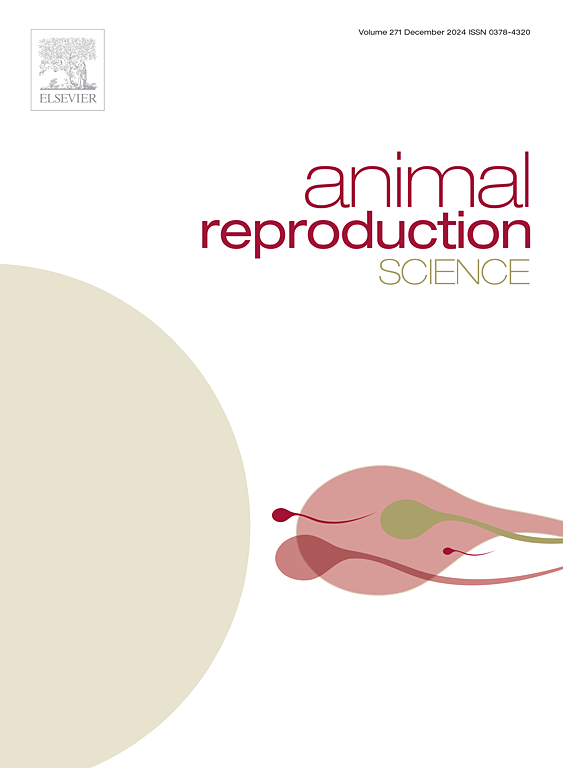Protective effect of β-carotene against lipopolysaccharide-induced meiotic maturation defects in porcine cumulus-oocytes complexes
IF 3.3
2区 农林科学
Q1 AGRICULTURE, DAIRY & ANIMAL SCIENCE
引用次数: 0
Abstract
Gram-negative bacterial infections are a leading cause of ovarian dysfunction and fertility impairment, primarily due to the adverse effects of the endotoxin lipopolysaccharide (LPS). β-Carotene possesses potent anti-inflammatory and anti-apoptotic properties. This study aimed to evaluate whether β-carotene could protect porcine cumulus-oocyte complexes (COCs) from LPS-induced damage. The results showed that 10 μg/mL LPS exposure inhibited cumulus expansion, reduced the extrusion rate of the first polar body (PB1), and induced meiotic defects, including spindle damage. Additionally, LPS treatment upregulated the expression of GRP78 and unfolded protein response (UPR)-related genes (PERK, IRE1, and ATF4) in cumulus cells. LPS exposure increased the proportion of apoptotic cells, upregulated the expression of the endoplasmic reticulum stress (ERS)-related apoptotic gene CHOP, and activated the downstream apoptotic program. In contrast, cotreatment with 5 μM β-carotene alleviated these adverse effects. Notably, β-carotene administration partially repaired the gap junction intercellular communication (GJIC) between cumulus cells and oocytes, as well as the density and quantity of transzonal projections (TZPs), and enhanced the expression of key proteins, including FSCN1, DAAM1 and MYO10. In summary, β-carotene protects porcine COCs from LPS-induced reproductive toxicity by improving meiotic maturation, alleviating LPS-induced spindle defects, mitigating ER stress and apoptosis, and repairing TZPs' structure.
β-胡萝卜素对脂多糖诱导的猪卵母细胞减数分裂成熟缺陷的保护作用
革兰氏阴性细菌感染是卵巢功能障碍和生育障碍的主要原因,主要是由于内毒素脂多糖(LPS)的不利影响。β-胡萝卜素具有有效的抗炎和抗细胞凋亡特性。本研究旨在探讨β-胡萝卜素是否能保护猪卵母细胞复合物(COCs)免受lps诱导的损伤。结果表明,10 μg/mL LPS可抑制积云扩张,降低第一极体(PB1)的挤压率,诱发纺锤体损伤等减数分裂缺陷。此外,LPS处理上调了GRP78和未折叠蛋白反应(UPR)相关基因(PERK、IRE1和ATF4)在积云细胞中的表达。LPS暴露增加了凋亡细胞的比例,上调了内质网应激(endoplasmic reticulum stress, ERS)相关凋亡基因CHOP的表达,激活了下游凋亡程序。与5 μM β-胡萝卜素共处理可缓解这些不良反应。值得注意的是,β-胡萝卜素部分修复了卵丘细胞与卵母细胞之间的间隙连接细胞间通讯(GJIC),以及跨区突起(TZPs)的密度和数量,并增强了FSCN1、DAAM1和MYO10等关键蛋白的表达。综上所述,β-胡萝卜素通过促进减数分裂成熟、减轻lps诱导的纺锤体缺陷、减轻内质网应激和细胞凋亡以及修复TZPs的结构,保护猪COCs免受lps诱导的生殖毒性。
本文章由计算机程序翻译,如有差异,请以英文原文为准。
求助全文
约1分钟内获得全文
求助全文
来源期刊

Animal Reproduction Science
农林科学-奶制品与动物科学
CiteScore
4.50
自引率
9.10%
发文量
136
审稿时长
54 days
期刊介绍:
Animal Reproduction Science publishes results from studies relating to reproduction and fertility in animals. This includes both fundamental research and applied studies, including management practices that increase our understanding of the biology and manipulation of reproduction. Manuscripts should go into depth in the mechanisms involved in the research reported, rather than a give a mere description of findings. The focus is on animals that are useful to humans including food- and fibre-producing; companion/recreational; captive; and endangered species including zoo animals, but excluding laboratory animals unless the results of the study provide new information that impacts the basic understanding of the biology or manipulation of reproduction.
The journal''s scope includes the study of reproductive physiology and endocrinology, reproductive cycles, natural and artificial control of reproduction, preservation and use of gametes and embryos, pregnancy and parturition, infertility and sterility, diagnostic and therapeutic techniques.
The Editorial Board of Animal Reproduction Science has decided not to publish papers in which there is an exclusive examination of the in vitro development of oocytes and embryos; however, there will be consideration of papers that include in vitro studies where the source of the oocytes and/or development of the embryos beyond the blastocyst stage is part of the experimental design.
 求助内容:
求助内容: 应助结果提醒方式:
应助结果提醒方式:


